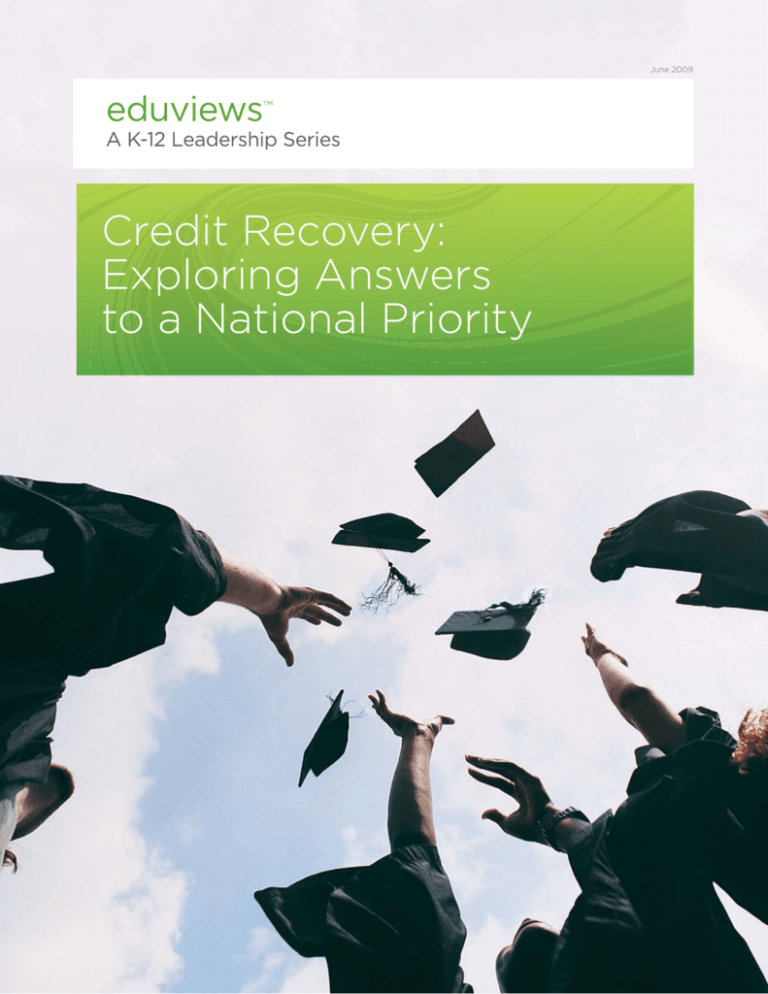
June 2009
Credit Recovery:
Exploring Answers
to a National Priority
Credit Recovery:
Exploring Answers to a National Priority
It has been called the “silent epidemic” affecting our nation’s high schools.1
High dropout rates dim individual students’ prospects and put our nation’s
communities and future at risk. The costs are staggering, both in terms of financial
disadvantage and social impacts. High school dropouts earn on average $9,200 less
per year than high school graduates. They are more likely to be unable to support
themselves and three times more likely than college graduates to be unemployed.
Even more daunting is the likelihood that they’ll slip into poverty from one year to the
“Strong credit recovery programs
help to knock out excuses for
students not to succeed.”
Ms. Rose Valderaz
Director, Virtual High School
Ector County, Texas
next.2 In many cases, students in elementary and middle school have high ambitions
and they plan to graduate high school and go on to college. Yet, as students move
through their secondary school experiences, the process of gradual disengagement
begins. Sometimes students report that they are bored or disinterested, and in other
cases, family issues and priorities take precedence.
The consequences of disengagement are startling. During a recent town hall meeting
on the nation’s dropout crisis, Bob Wise, former West Virginia Governor, stated that
“…30 percent of teens, or 1.2 million, don’t graduate from high school on time. That
number jumps up to nearly 50% for minority teens.”3 Wise noted that high school
dropouts from the class of 2008 will cost the United States an estimated $319 billion
over their lifetime. That estimate includes income the students will have lost because
of lack of education and costs associated with publicly funded healthcare, prison stays
and other services.
A closer look at the results of a recent study on this subject reveals that over 60
percent of the students who eventually dropped out of high school failed at least 25
“Back in my junior year of high
school, I had no hopes of
graduating until I talked to my
counselor about the Center
for Online Studies in Littleton
School District. Now I have a
week left to graduation. If it
weren’t for COLS, I would not
be graduating.”
High School Student Interview5
Littleton, Colorado
percent of their credits in the ninth grade, while only 8 percent of their peers who
eventually graduated had similar difficulty.4 As the results reveal, credit recovery
may be an effective strategy to improve graduation rates. As guidance counselors,
principals and administrators emphatically point out, for many students (including
those who leave because of boredom) dropping out of school is a slow process of
increasing disengagement.
The March 26, 2009 edition of Education Week contained a special insert, Technology
Counts, focused on the evolution of e-education opportunities and achievement.
The overview to the issue observes that “one of the biggest growth areas in online
education has been in credit recovery, which is for students who have failed or
not completed a core course needed for graduation.” 6 As educational leaders,
practitioners, policy-makers, politicians and parents will attest, improving our nation’s
high school graduation rates is a critical objective. Any strategy that supports
improved graduation rates merits closer attention. According to Dr. Anthony G.
Picciano, Professor and Executive Officer, Ph.D. Program in Urban Education for
the Graduate Center — City University of New York and a researcher with The
Sloan Consortium, “Anything we can do to ease this crisis needs to be considered,
including online credit recovery programs. We know that online learning is expanding
throughout American secondary education and it is only natural that it should play a
role in addressing the drop-out crisis.” 7
A Closer Look at 21st Century Credit Recovery
As the education industry and its partners in the community at large expand their
exploration of credit recovery strategies and opportunities, it is critical to establish a
shared working definition. The International Association for Online Learning (iNACOL)
defines credit recovery as passing and receiving credit for a course in which a student
Online learning can be
used to address and
was previously unsuccessful in earning academic credit toward graduation.8 It is
capitalize on a student’s
important to note that in the iNACOL definition, “credit” is distinguished from “first
individual learning style
time credit” in that students have already satisfied seat time requirements for the
course in which they were initially unsuccessful and instead can focus on earning
and make it possible to
credit based on competency as defined by content standards. iNACOL also points out
differentiate learning
that the goals of credit recovery programs typically focus on helping students stay in
more effectively, based on
school and graduate on time.
Another definition of credit recovery is offered in the Arizona Department of
continuous assessment
Education AIMS Intervention and Dropout Prevention Program Toolkit. This description
and adjustments to
states, “Most credit recovery programs identify the population they serve as students
individual student needs.
who are toward the second half of their high school career, who are older, and whose
main focus is the completion of the credit requirements to graduate from high school.
By being in the second half of their high school careers, it means that the students
have already earned approximately 1/2 of the credits needed for graduation.” This
description also notes that credit recovery programs are “…distinct from alternative
programs designed for students who need to be in a setting other than standard
education for the majority of their school career.” 9
Interestingly, the use of online learning platforms for credit recovery appears to be
increasing. The 2008 report from America’s Digital Schools indicates that more than
60 percent of the 4,000 technology directors surveyed nationwide report usage of a
digital Learning Management Systems (LMS) for credit recovery applications.10
Credit recovery
Electronic supplement to traditional courses
Core curriculum online student courses
Multi-purpose district portal
Professional development for teachers
Professional development for administrators and all staff
Advanced placement
0%
20%
40%
60%
80%
100%
Percentage of Districts Using LMS Systems
Used Widely
Used
Used Somewhat
Source: America’s Digital Schools 2008 Report: The Six Trends to Watch11
2
Credit Recovery Models: Evolving Opportunities for Students
and Their Schools
Credit recovery programs have become far more innovative than the traditional
“summer school” of years past. In the 21st century learning environment, credit recovery
models are remarkably varied and flexible. The summer school option continues, and
now, many schools and districts also offer students credit recovery opportunities
before and after school during the regular school year, along with weekend classes,
and programs that are available during the school day. In all of these models, online
instruction is delivering important benefits to students and schools alike, because of its
efficiencies, flexibility, and cost effectiveness.
The “where” of credit recovery courses is also evolving. School campuses, alternative
sites (such as community colleges, public libraries, and other municipal facilities), and
online programs are all serving as venues for successful high school credit recovery
program delivery.
Online instruction is rapidly becoming an essential part of the credit recovery
Online instruction is
landscape. Some schools and districts opt for a model that delivers credit recovery
delivering important
courses totally online. Others choose a hybrid model that combines online instruction
benefits to students and
credit recovery courses ranges from the purchase of “off the shelf” online course
schools alike, because of
content to courses developed by the district or school.
its efficiencies, flexibility,
Dr. Anthony Picciano, researcher with The Sloan Consortium, believes that online
and cost effectiveness.
learning will continue to grow. “My sense is that online credit recovery will increase
and student work with a face-to-face teaching environment. The source for online
over the next several years. We saw a definite blip upwards in the number of school
districts using online credit recovery between our first study in 2007 and our
follow-up study in 2009. I think that the nature of online credit recovery will expand
to make greater use of blended learning techniques, rather than using the fully online
model. The reason for this is that students who struggle in courses tend to need
more individual attention and the blended environment may be more conducive to
individualization than the fully online or fully face-to-face models.” 12
Still other institutions are tapping the resources of state-based virtual school providers
and course developers. Educators interviewed for this report indicated that often,
the most effective model for credit recovery is frequently a blended/hybrid model,
because students often benefit from and need the additional support of real-time
face-to-face interaction with a teacher but need the personalization and flexibility that
online learning affords.
Credit Recovery in Ector County, Texas
“We, as a team, knock out any excuse for any of our students to
not be successful.”
With a district enrollment of 26,000 students, Ector County is working to increase graduation
rates using credit recovery courses delivered both in online and in offline formats. The district did
extensive research before embarking on their current credit recovery approaches, including site
visits to other districts in Texas. Rather than selecting one model for credit recovery, the district
chose to offer multiple models in order to address as many students’ needs as possible.
Ms. Rose Valderaz, the district’s Director of the Virtual High School, notes, “We pride ourselves in
the use of Blackboard as an international platform that prepares our students for college/university
online learning. We are importing courses into the Blackboard platform from class.com and using
courses purchased from American Preparatory Institute.” When asked about the student services
Ector County provides, Ms. Valderaz states, “We open our lab from 7a.m.-9 p.m. and during that
time we offer the support of certified teachers, tutors, and counselors. We’re offering homework
assistance and tutoring assistance, along with mentoring support for students who need those
services. We team with all of our secondary schools, including the alternative schools, our night
staff and online teachers to make the best possible plan to meet our students’ individual needs.”
Ector County offers two kinds of credit recovery. They provide credit by exam, a paper-based
program, offered at each of the district’s secondary campuses, every 6 weeks from 4-6 p.m. daily,
for five weeks. They also offer credit recovery online, which offers complete courses in six-weeks,
with standard online student-teacher interaction. The online option does not offer a “test-out”
approach. The district also provides credit recovery opportunities during normal school hours in
addition to the before/afterschool programs. They also offer a district-wide 12-month program
which includes summer school credit recovery and online advancement.
Ms. Valderaz noted that district teachers working as teacher of record for the online courses
do customize the course. She pointed out that this adds a personal touch to the curriculum.
The teachers add a syllabus, pacing chart, banners, and announcements to create a classroom
atmosphere fully supported with face-to-face assistance if needed. She said, “While the program
is still new, I know that it has helped. This is the only thing we are offering in our district as an
alternative education offering. I definitely feel that we will make a difference in graduation rates.”
She also noted that the district is piloting a program in which one group of junior high students
is taking Geometry B and simultaneously taking Geometry A online, after failing Geometry A first
semester, in order to pick up missing skills. The goal is to determine if students can learn enough
of the skills and concepts they missed to complete the entire course with the goal of earning
full credit.
4
A Closer Look at the Data
“In 2004, a synthesis of new research on K-12
In the 2006-07 school year, Florida Virtual School
online learning reported results across five major
(FLVS) students who self-reported taking courses
meta-analyses. The authors reported that on
for credit recovery had a passing rate of 90.2
average, students perform equally well or better
percent, similar to the 91.2 percent passing rate for
academically in formal online learning situations as
the entire FLVS student population.14
students under traditional instruction.” 13
Online Learning: Growing Proof of Efficacy
An article entitled Research shows Evolving Picture of E-Education published in the
2009 Technology Counts issue of Education Week states, “Online classes may be a
relatively young instructional practice for K-12 schools, but experts already generally
agree on one point: Research shows that virtual schooling can be as good as, or better
than, classes taught in person in brick-and-mortar schools.” Author Debra Viadero
notes that, “…some new research also finds that online courses are beginning to score
more successes with the lowest achievers—possibly because many are high school
students who see the online courses as a last chance to earn enough credits
to graduate.” 15
Revisiting Pedagogy for Credit Recovery
Online learning can
Curriculum experts frequently point out that the integration of online learning
provide an environment
strategies often opens new opportunities for success for students enrolled in credit
in which instruction can
be delivered in new or
different formats for
students who were
previously unsuccessfully
in a course.
recovery programs. Online learning can provide an environment in which instruction
can be delivered in new or different formats for students who were previously
unsuccessful in a course. Online course delivery provides much needed flexibility and
dimension, including:
• Capacity to deliver multimodal, individualized, and self-paced learning experiences
• Technology to engage students in interactive content, using animation, simulations,
video, and audio, and to provide immediate feedback as students complete tasks
and assessments
• Flexible pacing to support the learning momentum of each individual student
• Authentically personalized instruction that can focus on the needs of individual
students, so that students do not need to repeat what they already know and
can accomplish.
Because students can often learn at their own pace, review and repeat instruction
as needed, and can take advantage of the flexibility offered by a digital learning
environment, they are often better able to grasp the essential content and concepts
required for satisfactory course completion.
The Kentucky Virtual High School Experience
The Kentucky State Department of Education operates an innovative credit recovery program.
Beth Gaunce, Program Consultant said, “Our program is in place because our state’s schools
and districts were trying to find alternative ways to make up student credit. Some contracted
with another vendor but realized that was not sufficient. Our program’s enrollment is open for
summer, spring, and fall, so credits can be retrieved and students stay on track for graduation.”
In the Kentucky program, students take an abridged version of the whole course. Informal
diagnostics are completed and then students are either placed in the full course or they are
assigned to a separate abridged course managed by a teacher who also works with a number
of other students individually. Kentucky has developed about 50 percent of its own courses and
purchases the rest from a variety of providers. According to Jamie Keene, the program’s Branch
Manager, only students scoring 50 percent and above are eligible for credit recovery. Students
who score below 50 percent are not eligible for this credit recovery program. Program officials
note that instruction is different in the credit recovery format and is approached as a strategy
to prevent dropouts. Students experience frustration if they are required to go over the same
content and need specialized instruction to meet their needs. This credit recovery program is
offered as an alternative to schools and districts and is a strategy to assure that students will
get what they need.
Program officials also noted that when districts or schools do not have the resources to pay
teachers for credit recovery courses, Kentucky Virtual High School is a great resource. Tuition
ranges from $150 for credit recovery full credit to $300 for a full credit, 2-semester course
making it affordable for participating schools and districts.
While current economic pressures have made it more difficult for the state to develop more
courses, the program’s staff already have their eyes on the future, with plans to modularize
content and develop it in the style of learning modules/objects, with pre and post-tests for
diagnostics. The goal is that the instructional content will be used for full courses and can be
personalized for individual students. Students would then have the opportunity to “test out” of
modules. Advises Beth Gaunce, “It’s important to modularize your program and build in strong
flexibility so teachers can be proactive in solving student learning issues.”
6
The Dollars and Sense of Credit Recovery
For a growing number of districts, online and hybrid approaches to credit
recovery are helping to accomplish core goals for graduation without dramatic
budget increases or heightened demands on staff and facilities. From a budgeting
perspective, online credit recovery often gives schools a strategy to retain students
in the school and as a result, keep the funding associated with those students. The
before/after school models enable students to attend school full-time and still make
up the courses they failed previously. Additionally, when schools can identify at-risk
students and bring them back into full-time attendance, schools can restore full
funding for those students.
From a staffing and personnel standpoint, online credit recovery enables one teacher
of record to serve many schools within a district or across a wider geographic
area. When schools provide online credit recovery on-site, students can often be
monitored and assisted by part-time instructional assistants. If the issue is one of
facilities, before and after school programs can leverage existing classrooms, labs and
library spaces, without significantly adding costs.
Expanding the Vision
Credit recovery programs
The successes of online and hybrid models for credit recovery open up several other
have the power and
potential directions for the future. For students in the middle grades, credit recovery
the demonstrated
ability to measurably
reduce dropout rates
strategies can help assure that students are better prepared for the rigors of high
school academics. Another interesting application has begun to emerge. Educators
are testing the idea of “concept recovery” as part of their remediation strategies,
borrowing some of the techniques used in successful credit recovery programs. Here,
students have the opportunity to re-learn and master essential concepts that are core
and improve students’
building blocks for progressive academic work. It is an innovation convergence of
chances of graduation.
both online learning and credit recovery strategies, applied in new ways.
As schools and districts evaluate strategies for improving graduation rates, online
and blended model credit recovery programs have become critical “go to” options.
These programs have the power and the demonstrated ability to measurably reduce
dropout rates and improve students’ chances of graduation. Credit recovery delivered
with online support enables educators to tailor instruction based on a student’s
specific skill gaps, so students can pass courses in which they did not initially
succeed. And credit recovery is also a way to help districts with larger transient
populations give students the opportunity to catch up with coursework, so they do
not lose credits as a result of school transfers.
Online Credit Recovery Offers Important Pedagogical Opportunities:
Excerpts from a Conversation with Dr. Anthony G. Picciano, The Sloan Consortium
When asked about the specific advantages to online credit recovery approaches and changes in
pedagogy that can make online credit recovery more effective for students and schools,
Dr. Anthony Picciano of The Sloan Consortium made several important observations. He noted,
“The most obvious benefit is that students who have not passed courses delivered in a traditional
mode may find credit recovery courses with an alternative format (e.g., online learning or a
blend of online and face-to-face instruction) better suited to their learning styles.” Beyond the
technological “chic” of online programs, many online courses allow students to proceed at their
own pace and in the comfort and security of their homes. Many online credit recovery programs
are also individualized and/or modularized so that teachers can customize the online courses to
the specific needs of students and not simply have them retake the entire course all over again
as is typically done in the face-to-face instructional model.
Picciano also underscored the impact of changing pedagogical approaches and their value in
online credit recovery stating, “Individualized instruction, modularization, multimedia infusion,
and on-going assessment are some of the pedagogical techniques that typify many online credit
recovery courses. In addition, there is a growing appeal to using blended learning techniques that
attempt to apply the best of both formats to help students who are struggling with a particular
course or content.”
Picciano pointed out that online credit recovery can also work to remove the stigma for students
having to repeat courses and can alleviate some of the strain teachers’ experience when
reteaching students who were unsuccessful the first time. Picciano specifically cited the value of
scaffolding modular approaches to concept and skill mastery, stating that the online environment
can be ideally suited for this kind of instructional approach. He also noted that online learning
can be used to address and capitalize on a student’s individual learning style and make it possible
to differentiate learning more effectively, based on continuous assessment and adjustments to
individual student needs.
8
Credit Recovery Online: A Powerful Strategy to Increase
Student Success
As every educator knows, doing more with less is critical in these challenging
economic times. Online credit recovery expands and optimizes instructional capacity,
leverages available resources, and provides significant opportunities to students
who may be at risk for failing specific courses or dropping out of school entirely,
all without adding significant burdens to staff and facilities costs. When students
drop out of school, they are disengaged, disconnected, and too often discouraged
about their in-school experiences. Online credit recovery is a way to stem the tide of
students dropping out.
In fact, 80 percent of the students responding to The Silent Epidemic survey said
their chances of staying in school would have increased if classes were more
interesting and provided opportunities for real-world learning17. Online credit recovery
and hybrid approaches can indeed address 21st century students’ needs for engaging
learning experiences in a real-world environment. This approach to credit recovery
will not answer the entire problem of high dropout rates. It will, however, deliver new
answers to more students and provide new and needed opportunities for students
to stay in and finish their high school educations. To borrow the words of Ms. Rose
Valderaz of Ector County, Texas, “Strong credit recovery programs help to knock out
excuses for students not to succeed.”
“My experience at the Center for Online Studies was a really good one and
the online portion of it, being in a small environment, was really great for
me because I was a 5th year senior. I fell very far behind and I had to do an
extra year. I did that extra year here (at COLS) to graduate. That was great
as I didn’t want to go back to a regular high school. I learned so much
more in this year.”
High School Student Interview16
Littleton, Colorado
Endnotes
1 Bridgeland, John, M, DiIulio, Jr, John and Morison, Karen Burke. The Silent Epidemic
Perspectives of High School Dropouts A report by Civic Enterprises in association with
Peter D. Hart Research Associates for the Bill & Melinda Gates Foundation.
March 2006.
2 Davis, Michelle. “Breaking Away From Tradition.” Technology Counts, Education Week,
Volume 28, No. 26 (2009): 9
3 ASCD SmartBrief, April 4, 2009, citing edweek.org article “High school dropouts cost U.S. $319B
over lifetime”, April 2, 2009.
4 Legters, Nettie and Kerr, Kerri, Easing the Transition to High School: An Investigation of Reform
Practices to Promote Ninth Grade Success, Center for Social Organization of Schools, Johns
Hopkins University, 2001
http://www.scusd.edu/com_office/fcpro/legters.pdf
5 Interview conducted with Littleton County high school students, 2008.
Video of full interview available at http://www.k12perspectives.com/.
6 Davis, Michelle, (2009).
7 Picciano, A.G. & Seaman, J. (2009). K-12 Online Learning: A 2008 Follow-Up of the Survey of
U.S. School District Administrators. Needham, MA: The Sloan Consortium.
http://www.sloan-c.org/publications/survey/pdf/k-12_online_learning_2008.pdf
8 Watson, John and Butch Gemin, NACOL Promising Practices in Online Learning: Using Online
Learning for At-Risk Students and Credit Recovery, Research Report , July 2008, iNACOL: 3
9 Arizona Department of Education, AIMS Intervention and Dropout
Prevention Toolkit
https://www10.ade.az.gov/AIMSDPToolkit/TrautmanAndLawrenceFormatted.aspx
10 America’s Digital Schools 2008, http://www.ads2008.org
11 America’s Digital Schools (2008).
12 Picciano, A.G. & Seaman, J. (2009).
13 Technology in Schools: What the Research Says. Report by Metiri Group, commissioned by
Cisco Systems 2006. Contacts: Charles Fadel, Global Lead, Education; Cisco Systems, Inc., Cheryl
Lemke, CEO, Metiri Group; By Metiri Group—Commissioned by Cisco Systems: 9
14 Press Release, Florida Virtual School, Online Learning FLVS Launches Learning Recovery Center
(January 21, 2009) (available at: http://www.flvs.net/general/press/headlines/2009/Learning%20
Recover%20Center%20ReleaseFINAL.pdf)
15 Davis, Michelle, (2009).
16 Interview conducted with Littleton County high school students, 2008.
17 Bridgeland, John, M, DiIulio, Jr, John and Morison, Karen Burke. (2006).
10
Worldwide Headquarters
650 Massachusetts Ave, NW, 6th Fl.
Washington, DC 20001
+ 1.800.424.9299, ext. 2427
+ 1.202.463.4860, ext. 2427
K-12
blackboard.com/k12
Copyright © 1997–2009. Blackboard Inc. All rights reserved.









